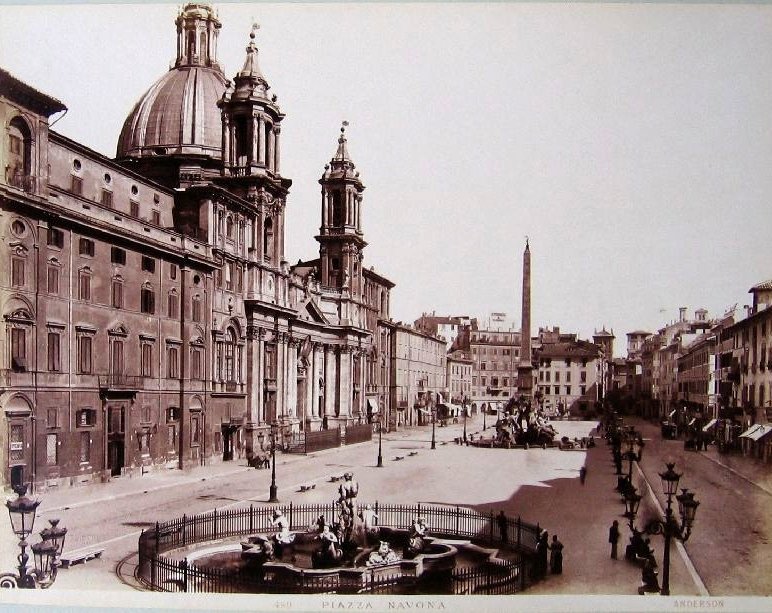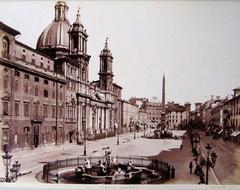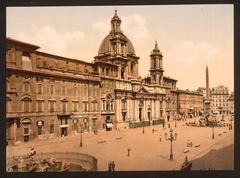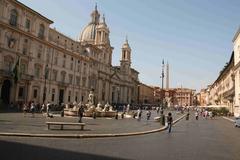
Palazzo Pamphilj: Visiting Hours, Tickets, and Historical Significance in Rome
Date: 14/06/2025
Introduction: The Grandeur and Cultural Importance of Palazzo Pamphilj
Palazzo Pamphilj, a striking Baroque masterpiece on Rome’s Piazza Navona, stands as a testament to the power and ambition of the Pamphilj family. Commissioned in the 17th century under Pope Innocent X (Giovanni Battista Pamphilj), the palace reflects the era’s artistic innovation and Rome’s evolving social landscape. Designed chiefly by Girolamo Rainaldi, with Francesco Borromini adding notable interior embellishments, the palazzo’s restrained classical lines contrast with the more exuberant Roman Baroque style, offering a unique architectural experience. The palace’s ceilings, particularly Pietro da Cortona’s frescoes celebrating the apotheosis of Aeneas, highlight the family’s mythic legacy and Rome’s classical roots.
Over centuries, Palazzo Pamphilj transitioned from papal residence to diplomatic hub—since 1920, it has housed the Embassy of Brazil. Today, its public spaces, such as the famed rooftop terrace, host cultural events, offering visitors a living connection to Rome’s vibrant past and present. To truly appreciate this landmark, understanding its origins, artistic heritage, and visitor logistics is essential. This guide covers everything you need to plan your visit: from history and architecture to accessibility, tickets, and travel tips. It also clarifies distinctions between Palazzo Pamphilj and the similarly named Palazzo Doria Pamphilj, ensuring a deeper understanding of Rome’s noble residences. (Wikipedia, Turismo Roma, Rome.info, Summer in Italy)
Table of Contents
- Introduction
- Origins and Construction
- Architectural Significance
- Notable Residents and Historical Events
- Artistic Heritage
- Palazzo Pamphilj’s Role in Roman History
- Transformation and Modern Use
- Visitor Information
- Distinction from Palazzo Doria Pamphilj
- Frequently Asked Questions (FAQ)
- Suggested Images and Interactive Elements
- Internal and External Links
- Conclusion and Recommendations
- References
Origins and Construction
Palazzo Pamphilj’s origins trace back to the rise of the Pamphilj family, particularly after Giambattista Pamphilj became Pope Innocent X in 1644. Seeking to showcase their newfound prominence, the family commissioned a grand palace, integrating existing properties on Piazza Navona and Via Pasquino. Architect Girolamo Rainaldi began work in 1646, and his son Carlo Rainaldi later completed the project. The palace was designed to assert the family’s power and provide a fitting residence for the papal dynasty (Wikipedia).
Architectural Significance
Palazzo Pamphilj is a prime example of Baroque architecture tempered by classical restraint. The façade features a rhythmic sequence of windows and pilasters facing Piazza Navona, reflecting Rainaldi’s preference for symmetry and proportion. Francesco Borromini contributed to the interiors, particularly the Gallery, which connects the palace to Sant’Agnese in Agone. Borromini’s design introduced large Serliana windows, infusing the Gallery with natural light and establishing a visual dialogue with the square outside.
The palace’s layout includes three courtyards and a piano nobile (main floor) adorned with frescoes by artists such as Giacinto Gimignani, Gaspard Dughet, Andrea Camassei, and, most notably, Pietro da Cortona. Cortona’s ceiling frescoes, completed between 1651 and 1654, depict the mythic life of Aeneas, symbolizing the Pamphilj’s claimed descent from the hero and Rome’s legendary founders (Wikipedia).
Notable Residents and Historical Events
Palazzo Pamphilj was not only a symbol of papal authority but also a stage for influential figures. Olimpia Maidalchini, Pope Innocent X’s sister-in-law, played a critical role in the palace’s construction and Roman society. Her suites overlooked Piazza di Pasquino, while the pope’s apartments faced Piazza Navona, linked by Borromini’s Gallery. The palace further gained prominence through family alliances—most notably the marriage of Camillo Pamphilj to Olimpia Aldobrandini, which ultimately brought Palazzo Doria Pamphilj into the family sphere (Rome.info).
Artistic Heritage
The palazzo’s interiors are celebrated for their artistic refinement. Pietro da Cortona’s frescoes in the Gallery remain a highlight, narrating the “Apotheosis of Aeneas” and exemplifying Baroque storytelling. The piano nobile features works by major 17th-century artists, reflecting the Pamphilj’s cultural ambitions and the seamless blending of art and architecture.
Palazzo Pamphilj’s Role in Roman History
As the residence of Pope Innocent X, Palazzo Pamphilj became a hub of papal administration and high society. Its location on Piazza Navona amplified its political and cultural stature, and the Pamphilj family’s alliances with other noble houses helped shape Rome’s aristocratic landscape in the 17th and 18th centuries (Rome.info).
Transformation and Modern Use
Over time, the Pamphilj family’s influence diminished, but the palace retained its status as a landmark. In the 20th century, it was leased to the Brazilian government, becoming the Embassy of Brazil in Italy in 1920. In 1960, Brazil purchased the property. Today, the palace blends its historical legacy with modern diplomatic functions and cultural events, such as concerts and exhibitions, especially on its panoramic rooftop terrace (Wikipedia).
Visitor Information
Visiting Hours
- Public spaces (including rooftop terrace restaurant): Generally open daily from 10:00 AM to 7:00 PM.
- Embassy areas: Access is restricted; guided tours must be arranged in advance.
Tickets
- Public areas: Free entry, but reservations are recommended for guided tours and events.
- Special events: Fees may apply; check with the embassy or event organizer for details.
Accessibility
- Wheelchair access: Limited; contact the embassy or tour providers for details and accommodations.
- Facilities: No public cloakrooms or lifts; some areas may be inaccessible to visitors with mobility challenges.
Guided Tours
- Languages: Italian, English, and others upon request.
- Booking: Tours must be booked in advance via the Embassy Cultural Office.
Getting There
- Address: Piazza Navona, Rome.
- Nearest metro: Barberini (Line A), 15-minute walk.
- Bus stops: Corso Rinascimento, Corso Vittorio Emanuele II.
- Nearby landmarks: Pantheon, Campo de’ Fiori, Sant’Agnese in Agone.
Nearby Attractions
- Piazza Navona: Famous fountains and vibrant street life.
- Pantheon: Ancient Roman temple.
- Doria Pamphilj Gallery: Exquisite private art collection.
- Campo de’ Fiori: Historic market and nightlife hub.
Distinction from Palazzo Doria Pamphilj
It’s crucial to distinguish Palazzo Pamphilj on Piazza Navona from Palazzo Doria Pamphilj on Via del Corso. The latter is renowned for its private art collection, including works by Caravaggio, Raphael, Velázquez, and Bernini. Palazzo Pamphilj, in contrast, is notable for its papal history, Baroque architecture, and diplomatic role (Rome.info).
Frequently Asked Questions (FAQ)
Q: What are the visiting hours of Palazzo Pamphilj?
A: Public areas are usually open 10:00 AM–7:00 PM; guided tours require advance reservation.
Q: How do I get tickets to visit?
A: Entry is generally free, but tours and events require booking via the embassy.
Q: Is the palace wheelchair accessible?
A: Accessibility is limited; contact the embassy for details.
Q: Are tours available in English?
A: Yes, upon request.
Q: Can I take photos inside?
A: Restrictions may apply—ask your guide or embassy contact.
Suggested Images and Interactive Elements
- Images of the façade on Piazza Navona (alt: “Palazzo Pamphilj façade in Piazza Navona, Rome”)
- Interior photos of Pietro da Cortona frescoes (alt: “Frescoes by Pietro da Cortona in Palazzo Pamphilj”)
- Rooftop terrace views (alt: “View from Palazzo Pamphilj’s rooftop terrace”)
- Interactive map of Rome showing Palazzo Pamphilj and nearby attractions
- Virtual tour links (when available)
Internal and External Links
- Official resources: Brazilian Embassy in Italy
- Tourism info: Rome.info, Turismo Roma
- Doria Pamphilj Gallery, Pantheon, Trevi Fountain
Conclusion and Recommendations
Palazzo Pamphilj embodies the grandeur of Baroque Rome, offering visitors a rare glimpse into papal history, aristocratic life, and artistic innovation. Its unique blend of historical, artistic, and diplomatic significance makes it a must-see for anyone exploring Rome’s cultural treasures. Because access is regulated and visits are often by appointment, plan ahead and coordinate with the embassy for tours or cultural events. Enhance your visit by exploring nearby landmarks and using digital resources like virtual tours and interactive maps.
To enrich your Roman adventure, download the Audiala app for expert guides, audio tours, and the latest updates on Rome’s historical sites.




















































































































































































































































